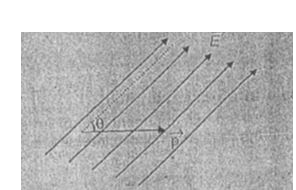A magentic dipole in a constant magnetic field has
maximum potential energy when the torque is maximum
zero potential energy when the torque is maximum
zero potential energy when the torque is minimum
minimum potential energy when the torque is maximum
The correct Answer is:B
To solve the question regarding the relationship between the potential energy and torque of a magnetic dipole in a constant magnetic field, we will follow these steps:
Step 1: Understand the Definitions
- The magnetic dipole moment is represented as P.
- The magnetic field is represented as E.
- The angle between the magnetic dipole moment and the magnetic field is represented as θ.
Step 2: Write the Formula for Potential Energy
The potential energy (U) of a magnetic dipole in a magnetic field is given by the formula:
U=−P⋅E=−PEcosθ
where:
- U is the potential energy,
- P is the magnetic dipole moment,
- E is the magnetic field strength,
- θ is the angle between P and E.
Step 3: Write the Formula for Torque
The torque (τ) experienced by a magnetic dipole in a magnetic field is given by:
τ=P×E=PEsinθ
where:
- τ is the torque,
- P is the magnetic dipole moment,
- E is the magnetic field strength,
- θ is the angle between P and E.
Step 4: Analyze the Options
1. Maximum Potential Energy when Torque is Maximum:
- Torque is maximum when θ = 90° (since sin 90° = 1).
- At θ = 90°, potential energy becomes:
U=−PEcos(90°)=−PE⋅0=0
- Thus, potential energy is not maximum when torque is maximum. This option is incorrect.
2. 0 Potential Energy when Torque is Maximum:
- As established, torque is maximum when θ = 90°, leading to:
U=0
- Therefore, this statement is true. This option is correct.
Conclusion
The correct answer is that the potential energy is zero when the torque is maximum.
---
- The magnetic dipole moment is represented as P.
- The magnetic field is represented as E.
- The angle between the magnetic dipole moment and the magnetic field is represented as θ.
The potential energy (U) of a magnetic dipole in a magnetic field is given by the formula:
U=−P⋅E=−PEcosθ
where:
- U is the potential energy,
- P is the magnetic dipole moment,
- E is the magnetic field strength,
- θ is the angle between P and E.
The torque (τ) experienced by a magnetic dipole in a magnetic field is given by:
τ=P×E=PEsinθ
where:
- τ is the torque,
- P is the magnetic dipole moment,
- E is the magnetic field strength,
- θ is the angle between P and E.
1. Maximum Potential Energy when Torque is Maximum:
- Torque is maximum when θ = 90° (since sin 90° = 1).
- At θ = 90°, potential energy becomes:
U=−PEcos(90°)=−PE⋅0=0
- Thus, potential energy is not maximum when torque is maximum. This option is incorrect.
- As established, torque is maximum when θ = 90°, leading to:
U=0
- Therefore, this statement is true. This option is correct.
The correct answer is that the potential energy is zero when the torque is maximum.
Topper's Solved these Questions
Similar Questions
Find the ratio of magnetic dipole moment and magnetic field at the centre of a disc. Radius of disc is R and it is rotating at constant angular speed o about its axis. The disc is insulating and uniformly charged
View SolutionA coil is placed in a constant magnetic field. The magnetic field is parallel to the plane of the coil as shown in Fig. 3.28. Find the emf induced in the coil if B increasing.

View SolutionA magnetic dipole is acted upon by two magnetic fields with inclined to each other at an angle of 75∘. One of the fields has a magnitude of 15 mT. The dipole attains stable equilibrium at an angle of 30∘ with this field. The magnitude of the other field (in mT) is close to
View SolutionSketch the magnetic field lines for a current-carrying circular loop near its centre. Replace the loop by an equivalent magnetic dipole and sketch the magnetic field lines near the centre of the dipole. Identify the difference.
View SolutionFind an expression for the magnetic dipole moment and magnetic field induction at the center of Bohr's hypothetical hydrogen atom in the nth orbit of the electron in terms of universal constant.
View SolutionA magnetic dipole is placed in a uniform magnetic field of intensity B, oriented along the direction of the field. If the magnetic dipole moment is M, then the maximum work an external agent can perform in rotating the dipole will be
View SolutionLet r be the distance of a point on the axis of a magnetic dipole from its centre. The magnetic field at such a point is proportional to
View SolutionLet r be the distance of a point on the axis of a magnetic dipole from its centre. The magnetic field at such a point is proportional to
View SolutionFind an expression fot the magneitc dipole moment and magnetic field induction at the centre of Bohr'r hypothetical hydrogen atom in the n th orbit of the electron in terms of universal constant.
View SolutionA dipole is placed in constant electric field E as shown . If it is released from rest this position find the kinetic energy gained when it is parallel to electric field vector .

( Assume dipole is small and placed in a gravity free space ) .
View Solution
